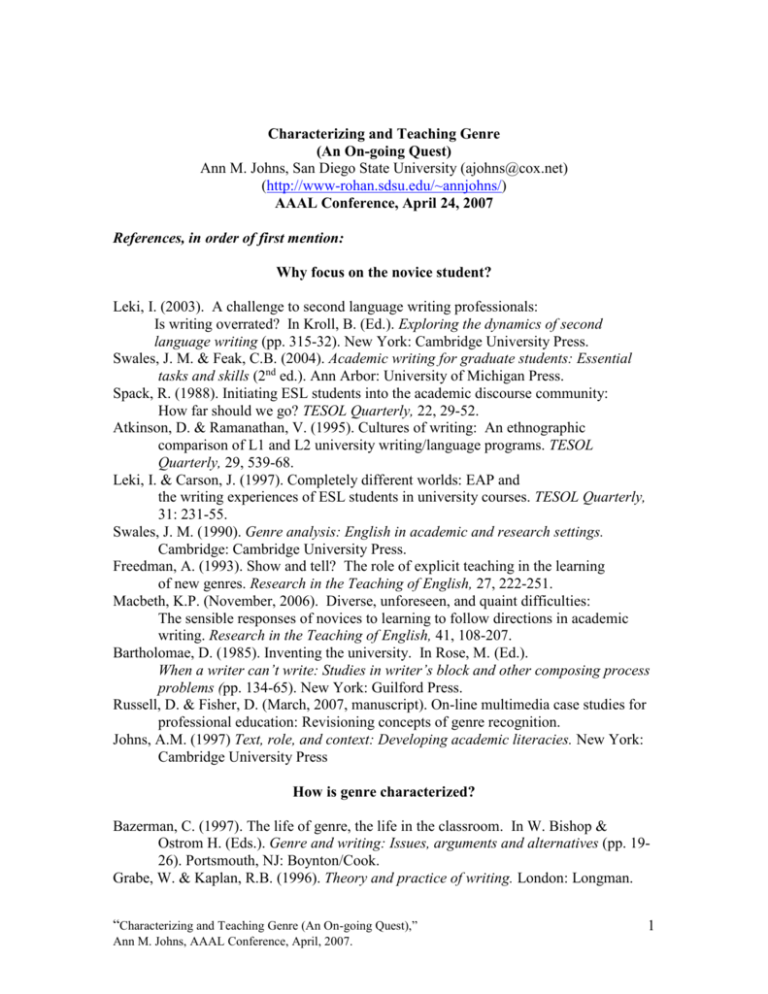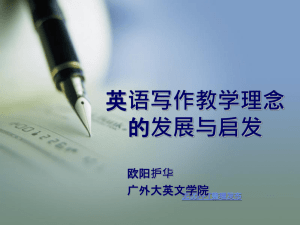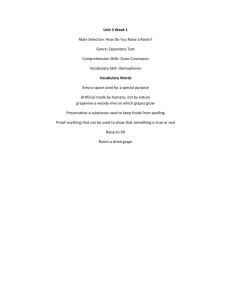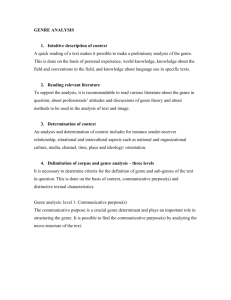Applying Genre Theory and Research to Academic Literacy
advertisement

Characterizing and Teaching Genre (An On-going Quest) Ann M. Johns, San Diego State University (ajohns@cox.net) (http://www-rohan.sdsu.edu/~annjohns/) AAAL Conference, April 24, 2007 References, in order of first mention: Why focus on the novice student? Leki, I. (2003). A challenge to second language writing professionals: Is writing overrated? In Kroll, B. (Ed.). Exploring the dynamics of second language writing (pp. 315-32). New York: Cambridge University Press. Swales, J. M. & Feak, C.B. (2004). Academic writing for graduate students: Essential tasks and skills (2nd ed.). Ann Arbor: University of Michigan Press. Spack, R. (1988). Initiating ESL students into the academic discourse community: How far should we go? TESOL Quarterly, 22, 29-52. Atkinson, D. & Ramanathan, V. (1995). Cultures of writing: An ethnographic comparison of L1 and L2 university writing/language programs. TESOL Quarterly, 29, 539-68. Leki, I. & Carson, J. (1997). Completely different worlds: EAP and the writing experiences of ESL students in university courses. TESOL Quarterly, 31: 231-55. Swales, J. M. (1990). Genre analysis: English in academic and research settings. Cambridge: Cambridge University Press. Freedman, A. (1993). Show and tell? The role of explicit teaching in the learning of new genres. Research in the Teaching of English, 27, 222-251. Macbeth, K.P. (November, 2006). Diverse, unforeseen, and quaint difficulties: The sensible responses of novices to learning to follow directions in academic writing. Research in the Teaching of English, 41, 108-207. Bartholomae, D. (1985). Inventing the university. In Rose, M. (Ed.). When a writer can’t write: Studies in writer’s block and other composing process problems (pp. 134-65). New York: Guilford Press. Russell, D. & Fisher, D. (March, 2007, manuscript). On-line multimedia case studies for professional education: Revisioning concepts of genre recognition. Johns, A.M. (1997) Text, role, and context: Developing academic literacies. New York: Cambridge University Press How is genre characterized? Bazerman, C. (1997). The life of genre, the life in the classroom. In W. Bishop & Ostrom H. (Eds.). Genre and writing: Issues, arguments and alternatives (pp. 1926). Portsmouth, NJ: Boynton/Cook. Grabe, W. & Kaplan, R.B. (1996). Theory and practice of writing. London: Longman. “Characterizing and Teaching Genre (An On-going Quest),” Ann M. Johns, AAAL Conference, April, 2007. 1 Samraj, B. (2002). Texts and contextual layers: Academic writing in content courses. In Johns, A.M. (Ed.). Genre in the classroom: Multiple perspectives (pp. 163-78). Mahwah, NJ: Lawrence Erlbaum. Rose, D. (2006). (handout). Learning to read; reading to learn. Rose, D. (1997). Science, technology, and technical literacies. In Christie, F. & Martin, J.R. (Eds.). Genres and institutions: Social processes in the workplace and school (pp. 40-72). London: Pinter. Bhatia, V.K. (2004). Worlds of written discourse: A genre-based view. London: Continuum. Miller, C. (1984). Genre as social action. Quarterly Journal of Speech, 70, 151-67. Coe, R.M. (2006) Crossing the boundaries of genre studies. [Co-written with A. Johns, A. Bawarshi, K. Hyland, B. Paltridge, M. J. Reiff, and C.M. Tardy.] Journal of Second Language Writing, 15, 234-49. Hasan, R. (1985). The structure of text. In Halliday, M.A.K. & Hasan, R. (Eds.) Language, context, and text (pp. 52-69). Geelong, Victoria: Deakin University Press. Chen, R. & Hyon, S. (in press). Faculty evaluation as a genre system: Negotiating intertextuality and interpersonality. Journal of Applied Linguistics. Schleppergrell, M. & Oliveira, L.C. (2006). An integrated language and content approach for history teachers. Journal of English for Academic Purposes (JEAP), 5, 254-269. [Special issue: Academic English in Secondary Schools, co-edited by Johns, A.M & Snow, M.A.] Mohan, B. & Slater, T. (2006). Examining the theory/practice relation in high school science register: A functional linguistic perspective. JEAP, 5, 302-16. Berkenkotter, C. & Huckin, T.N. (1995). Genre knowledge in disciplinary communication: Cognition/culture/power. Mahwah, NJ: Lawrence Erlbaum. How might the problem be solved? Hyon, S. (1996). Genres in three traditions: Implications for ESL. TESOL Quarterly, 30, 693-722. The New Rhetoric Russell, D. (1997). Rethinking genre in school and society: An activity theory analysis. Written Communication, 14, 504-54. Coe, R.M. (1994). Teaching genre as process. In Freedman, A. & Medway, P. (Eds.). Learning and teaching genres (pp. 157-72). Portsmouth, NH: Heinemann/Boynton-Cook. Devitt, A., Reiff, M.J., & Bawarshi, A. (2004). Scenes of writing: Strategies for composing with genres. London: Longman. Tardy, C.M. (2006). Researching first and second language genre learning: A comparative review and a look ahead. Journal of Second Language Writing, 15, 79-101. Bawarshi, A. (2003). Genre and the invention of the writer. Logan, Utah: Utah State “Characterizing and Teaching Genre (An On-going Quest),” Ann M. Johns, AAAL Conference, April, 2007. 2 University Press. Johns, A.M. (2007). AVID college readiness: Working with sources. San Diego, CA: AVID Center. English for Specific Purposes Flowerdew, J. (2002). Genre in the classroom: A linguistic approach. In Johns, A.M. Genre in the Classroom: Multiple perspectives (pp. 91-104). Mahwah, NJ: Lawrence Erlbaum. Swales, J.M. (1998). Other floors, other voices: A textography of a small university building. Mahwah, NJ: Lawrence Erlbaum. Hyland, K. (1999). Talking to students: Metadiscourse in introductory textbooks. English for Specific Purposes, 18, 3-26. Hyland, K. (1998). Hedging in scientific research papers. Amsterdam: Benjamins. Hyland, K. (2005). Stance and engagement: A model of interaction in academic discourse. Discourse Studies, 7, 173- 192. Bhatia, V.K. (1993). Analyzing genre: Language use in professional settings. London: Longman. Patridge, B. (2001). Genre and the language learning classroom. Ann Arbor: University of Michigan Press. Paltridge, B. (2006). In “Crossing the boundaries of genre studies.” JSLW. Samraj, B. (2004). Discourse features of the student-produced academic research paper: Variations across disciplinary courses. JEAP, 3, 5-22. Systemic Functional Linguistics (“The Sydney School”) Christie, F. (1991). Literacy in Australia. Annual Review of Applied Linguisitics, 12, 142-55. Martin, J.R. (1993). Genre and literacy---modeling context in educational linguistics. Annual Review of Applied Linguistics, 13, 141-72. Martin, J.R. (1998). Mentoring semogenesis: “Genre-based” literacy pedagogy. In Christie, F. (Ed.). Pedagogy and the shaping of consciousness: Linguistic and social processes. London: Cassell. Eggins, S. (2004). An introduction to Systemic Functional Linguistics. London: Continuum. Macken-Horarik, M. (2002). “Something to shoot for”: A Systemic Functional approach to teaching genre in secondary science. In Johns, A.M. (Ed.). Genre in the classroom: Multiple perspectives (pp. 17-42). Feez, S. (1998). Text-based syllabus design. Sydney, Australia: Macquarie University. What, then, are some promising possibilities? An Interdisciplinary Learning Community Johns, A.M. (2001). An interdisciplinary, interinstitutional, learning communities program: Student involvement and student success. In Leki, I. (Ed.). Academic “Characterizing and Teaching Genre (An On-going Quest),” Ann M. Johns, AAAL Conference, April, 2007. 3 writing programs (pp. 61-72). Alexandria, VA: TESOL. Johns, T. & Dudley-Evans, A. (1980). An experiment in team-teaching of overseas postgraduate students of transportation and biology. In Swales, J.M. Episodes in ESP (1988). (pp. 137-55). London: Pergamon Press. Harklau, L. (1999). The ESL learning environment in secondary school. In Faltis, C.J. & Wolfe, P. (Eds.). So much to say: Adolescents, bilingualism, and ESL in secondary school (pp. 105-37). New York: Teachers College Press. Short, D. (1999). Integrating language and content for effective sheltered English programs. In Faltis and Wolfe (pp. 105-137). General EAP: Grouping Disciplinary Responses into “Macro-genres” Carter, M. (February, 2007). Ways of knowing, doing, and writing in the disciplines. College Composition and Communication, 58, 385-418. Dutro, S. & Moran, C. (2003). Rethinking English language instruction: An architectural approach. In Garcia, G. (Ed.). English learners: Reaching the highest level of English literacy (pp. 227-258). Newark, NJ: International Reading Association. Related references: Bazerman, C. & Prior, P. (Eds.). (2004). What writing does and how it does it: An introduction to analyzing texts and textual practices. Mahwah, NJ: Lawrence Erlbaum. Coe, R.M., Lingard, L. & Teslenko, T. (2002). The rhetoric and ideology of genre. Cresskill, NJ: Hampshire: Hampton Press. Hasan, R. & Williams, G. (Eds.) (1996). Literacy in society. London: Longman. Hyland, K. (2003). Genre-based pedagogies: A social response to process. Journal of Second Language Writing, 12, 17-29. Johns, A.M. (2003). Genre in the ESL/EFL composition instruction. In Kroll, B. (Ed.). Exploring the dynamics of second language writing (pp. 195-217). New York: Cambridge University Press. Martin, J.R. (1992). English text: System and structure. Amsterdam: Benjamins. Ramanathan, V. & Kaplan, R.B. (2000). Genres, authors, discourse communities: Theory and application for L2 writers. Journal of Second Language Writing, 9, 171-192. Rose, D. (2004). Sequencing and pacing of the hidden curriculum: How indigenous learners are left out of the chain. In Muller, J. N., Davies, B., & Morais, A. (Eds.). Reading Bernstein, researching Bernstein. (pp. 91-107). London: RoutledgeFalmer. “Characterizing and Teaching Genre (An On-going Quest),” Ann M. Johns, AAAL Conference, April, 2007. 4 “Characterizing and Teaching Genre (An On-going Quest),” Ann M. Johns, AAAL Conference, April, 2007. 5








